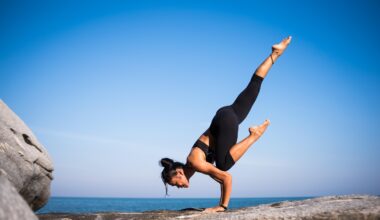Functional Training for Cyclists Over 40: Maintaining Performance and Health
As cyclists age, maintaining fitness and performance becomes increasingly crucial to enjoy the sport while prioritizing health. Functional training specifically targets the muscle groups used in cycling, thus allowing older athletes to optimize their strength, balance, and endurance. This approach emphasizes exercises that mimic daily activities, making it easier for individuals to incorporate workouts seamlessly into their routine. For cyclists over 40, the body experiences gradual changes such as decreased muscle mass and flexibility, necessitating targeted training to counteract these effects. Research indicates those who engage in functional training report enhanced cycling performance and reduced injury risks. Additionally, functional training fosters better posture on the bike, enabling riders to maintain an aerodynamic position effectively. As a result, cyclists are encouraged to integrate functional workouts into their regimen, focusing on key components such as core stability, leg power, and overall flexibility to ensure they remain competitive and healthy. In the following sections, we will delve into specific exercises and training programs tailored for cyclists in this age group to inspire lasting commitment to fitness. Exercise programs should adapt as individuals grow older, prioritizing sustainable health while enjoying cycling.
Understanding Functional Training
Functional training utilizes exercises that resemble movements performed during cycling or daily life, creating an efficient method to build strength, balance, and agility. For cyclists over 40, this training method is especially beneficial, as it addresses the muscular imbalances that often arise with age. Combining these exercises provides robust improvements to Cyclists’ performance while simultaneously reducing injury risk. This holistic approach promotes overall body coordination, addressing not just the legs but also the core and upper body, ensuring cyclists develop strength across all essential muscle groups. A well-rounded functional training program can include bodyweight exercises, free weights, and resistances bands, enabling older cyclists to maintain muscle mass and prevent decline with age. Some effective functional exercises for cyclists include squats, deadlifts, lunges, and planks, all focusing on core stability and leg strength. The introduction of spinning or using a stationary bike also enhances cardiovascular endurance, further elevating cycling performance. Lastly, it is essential to incorporate flexibility training through yoga or dynamic stretching to complement strength-building exercises, ensuring that cyclists maintain good mobility and reduced risk of injury during rides. Consistency and dedication to functional training are key to long-term success.
As cyclists age and progress beyond 40, it becomes vital to prioritize specific functional training programs. Athletes will experience a natural decline in strength, speed, and recovery rate, making targeted exercise routines essential for maintaining cycling performance. To establish a routine, cyclist enthusiasts can dedicate at least two to three sessions a week specifically focusing on functional training. These workouts can incorporate exercises designed for the whole body, aiming to enhance the core, legs, and upper body. Additionally, short, intense interval training sessions on a bike can effectively boost anaerobic fitness, resulting in improved overall cycling performance. Those dedicated to maintaining balance and control should also consider integrating proprioceptive exercises, including balance boards or single-leg drills. This will not only help enhance balance on the bike but also instill a sense of overall stability. To maximize these benefits, older cyclists should listen to their bodies, ensuring they remain well-hydrated and take adequate rest days between sessions. By implementing such tailored functional training regimens, cyclists over 40 can experience strength improvements, enhanced endurance, and prolonged enjoyment of outdoor rides for years to come.
Benefits of Functional Training for Cyclists
Functional training offers numerous benefits, particularly for cyclists over 40. Engaging in this form of exercise helps enhance muscle activation, core strength, and balance, which are crucial for optimizing performance on the bike. As riders reach this stage in life, addressing the natural decline in muscle mass and strength is essential. By incorporating functional training workouts, cyclists can improve not only explosive leg power but also overall endurance levels during long rides. Moreover, functional drills can reduce the risk of common injuries by improving joint stability and flexibility. These injuries, such as knee pain or lower back strain, tend to affect older cyclists, making preventive measures crucial. Another significant advantage is functionality; the exercises mimic day-to-day tasks enabling an easier transition to everyday activities while boosting cycling competence. Ensuring that training routines include both strength and flexility aspects leads to enhanced recovery times for cyclists, allowing for a more sustainable approach to fitness. By emphasizing holistic health and performance benefits tied to functional training, older cyclists will find renewed motivation and enhanced overall well-being as they pursue their passion for cycling.
One significant aspect of functional training is improving the core strength of cyclists over 40. A strong core plays a crucial role in maintaining an optimal riding position and overall cycling efficiency. Engaging in core-focused functional workouts can lead to reduced fatigue during long rides and improved power transfer from the legs to the bike. Common exercises like planks, Russian twists, and stability ball rollouts work to strengthen the core and build endurance. Additionally, these moves help prevent back injuries, which can be prevalent among older cyclists. To maximize core activation through functional training, it is recommended to move beyond traditional core exercises and include dynamic movements that challenge stability while engaging multiple muscle groups simultaneously. Incorporating unilateral exercises, such as single-arm rows or single-leg deadlifts, can also help cyclists develop balance and coordination essential for cycling performance. Adding a focused core day or integrating core exercises into regular workout sessions can yield significant improvements for riders over 40. Ultimately, maintaining core strength ensures cyclists can comfortably and efficiently tackle varied terrains over the years to come.
Creating a Functional Training Program
For cyclists over 40, establishing a well-balanced functional training program is essential for long-term engagement in the sport. An effective program should ideally target three main areas: strength, flexibility, and stamina. Reserve two to three weekly sessions specifically for functional workouts that include exercises for overall muscle groups. Sessions should focus on building the legs with movements like squats and lunges, strengthening the core through planks and rotations, and enhancing upper body strength using push-ups or rows. Cyclists should ensure to incorporate flexibility and mobility training in these sessions, utilizing dynamic stretching and yoga poses to maintain joint health and muscle elasticity. Gorgeous weather often calls attention to enjoyable outdoor cycling, making regular strength sessions particularly effective during the off-season. As flexibility is critical to preventing injuries, dedicating time to effective stretching that targets the legs, hips, and back can pay dividends during longer rides. Therefore, balancing the structure of these workouts will help ensure cyclists over 40 can maintain an enjoyable and healthy cycling journey, overcoming age-related hurdles while remaining active and fit.
Additionally, monitoring progress through effective training logs can enhance motivation and further improve results in functional training. Cyclists over 40 should consistently assess strength levels, endurance capabilities, and overall performance milestones throughout their training cycle. Documenting achievements encourages accountability and personalizes workout progress to align with desired goals. Recognizing gradual improvements in strength and endurance can inspire motivation to continue pushing boundaries while engaging in functional training. Maintaining a training log could include daily recorded workouts, cycling mileage, perceived exertion levels, and major achievements over time. Innovative tools like exercise apps or wearable tech can lend support to record and analyze data, allowing cyclists to adjust their functional training routines as necessary. Additionally, engaging in group workouts or classes can foster camaraderie and support, serving as a motivational boost for older cyclists. Working alongside others who share similar fitness goals promotes a sense of community and accountability, enhancing enjoyment in the exercise journey. In summary, tracking training achievements serves as a powerful motivator to continuously strive for improved performance while enjoying functional training sustainably and effectively.
Conclusion
Functional training offers tremendous benefits for cyclists over 40, responding to their unique fitness needs while promoting longevity and health in cycling. Incorporating targeted exercises that enhance strength, agility, core stability, and flexibility can ensure older cyclists achieve optimal performance and enjoyment. Through the implementation of customized training routines, individuals can counteract age-related performance declines while remaining competitive in their cycling pursuits. Each aspect of functional training addresses crucial components vital to holistic cycling fitness—from reducing injuries to boosting endurance levels during rides. By embarking on a consistent journey dedicated to functional training, cyclists over 40 can reinvigorate their passion for the sport while fostering a healthier lifestyle aligned with their fitness goals. It is essential to approach this training with sustainability in mind, allowing for necessary rest and recovery while being adaptable to potential lifestyle changes. Setting practical goals and charting progress should become priorities for older cyclists engaged in functional training. Ultimately, this commitment will cultivate the strength, resilience, and enjoyment needed to continue thriving as cyclists, ensuring that their passion for the road endures even as they gracefully age.


